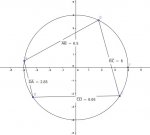The lines are a, b, c, d
The points are where those lines meet each other ie lines d and a intersect at point A, lines a and b intersect at point B, lines b and c intersect at point C, and lines c and d intersect at point D.
A, B, C, and D are the four corners of the trapezoid. This trapezoid is inscribed in a circle of radius 4cm.
I know that the lines a=6cm, d=6.5cm, and b+c=9.5cm, therefore I can draw points A and D. However I do not know the individual lengths of the lines b or c, therefore I don't know where to put points B and C.
The question is how do I find out the individual lengths of b and c so I know where to put B and C on the circle.
---------------------------
The lines are a, b, c, d
The points are where those lines meet each other ie lines d and a intersect at point A, lines a and b intersect at point B, lines b and c intersect at point C, and lines c and d intersect at point D.
A, B, C, and D are the four corners of the trapezoid. This trapezoid is inscribed in a circle of radius 4cm.
I know that the lines a=6cm, d=6.5cm, and b+c=9.5cm, therefore I can draw points A and D. However I do not know the individual lengths of the lines b or c, therefore I don't know where to put points B and C.
The question is how do I find out the individual lengths of b and c so I know where to put B and C on the circle.

